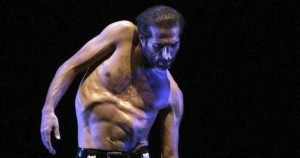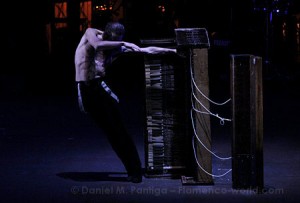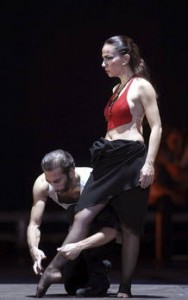By Rachel Straus
March 29 – April 9
Eiko & Koma
The Japanese avant-garde artists, whose home has been the U.S. since 1976, present the New York premiere of Naked at the Baryshnikov Arts Center. They will be intermittently naked, but what will stand out are their glacially slow movement tableaus that change one’s perception of time. Come with your patience, but know that you don’t have to stay the whole evening. The duo is offering Naked as an art installation. Audience members can come and go.
April 2
Dance of the Enchantress
At the Peter Norton Symphony Space, the South Indian classical dancer Vijayalakshmi will present herself in the dance style Mohiniyattam, which translates as “the Dance of the Enchantress.” According to ancient Indian legend, Vishnu the Preserver transformed himself into Mohini, an enchantress, in order to protect the universe from evil. Femininity and grace pervade the codified movements that alternate between pure dance and story telling. Performing along side Vijayalakshmi will be Palakal Rajagopalan (vocal), Muralee Krishnan (veena – lute), Sreekumar Kadampatt (edakka – hourglass-shaped drum), and Jayan Das (maddalam and mrdangam – double-headed tuned drums).
April 4
Merce Cunningham
On a monthly basis, the the Baryshnikov Arts Center has been showing Charles Atlas’ films of Merce Cunningham’s dances. Seeing Cunningham’s out-of-repertory works on a big screen is a boon to dance lovers. The next BAC flicks is eyeSpace (2006), which features music by David Behrman, costumes and sets by Daniel Arsham, and performances by the Cunningham dancers. The event begins with the webcast series called Mondays with Merce, which gives viewers deeper insight into Cunningham’s choreographic process. Valda Setterfield, a Cunningham performer from 1964-1974, will narrate and comment.
April 5-10
Stephen Petronio Dance Company
At the Joyce Theater, Stephen Petronio Company will present the New York premiere of Underland (2003). The work premiered with the Sydney Dance Company. It’s set to 14 songs by Australian rocker Nick Cave. It features multi-media projections by Mike Daly, another Down Under artist. Petronio’s evening-length work, now set on his 11 company members, is thick with movement and hipness.
April 8
“Ballet with a Modern Sensibility”
The 92nd St. Y’s “Fridays at Noon” free performance series continues with “Ballet with a Modern Sensibility.” Three choreographers—Christopher Caines, Brian Carey Chung, and Helen Heineman—will present excerpts of their new works, set to Italian Baroque music, and composers Meredith Monk, Arnold Schoenberg, Frédéric Mompou, Debussy, Beethoven, and Lou Harrison.
April 6-17
Ailey II
At The Ailey Citigroup Theater (the black box in the dance organization’s west 55 St. home), the second company will hold a two-week season. Six works and two programs will be danced by the 14-member Ailey II troupe, which travels the world almost as much as the parent company. The premieres include The Corner, a full ensemble work by Kyle Abraham—known for his fusion of popping, locking and post-modern dance—Doscongio by Robert Moses, set to two movements of Chopin’s Sonata for cello and piano (op. 65), and Shards by Donald Byrd, with music by Mio Morales.
April 14 – 16
Paradigm
At St. Mark’s Church, the pick-up troupe—comprised of dancers whose stage careers span several decades—will present two world premieres by its founding members, Carmen de Lavallade and Gus Solomons, Jr. The opening night performance will be followed by a celebration of Paradigm’s 15th anniversary and Carmen de Lavallade’s 80th birthday at Lautrec Bistro. You can join them, for a price, or just go to the show, which features a cast of eight veteran dancers, and a solo performance by Kyle Abraham, Solomon’s former student.
April 11
Dance Theatre of Harlem
At City Center Studio 5, Dance Theatre of Harlem’s artistic director Virginia Johnson and former New York City Ballet principal dancer Damian Woetzel will host an informal evening, focusing on the history of the first American black ballet company, founded at the height of the Civil Rights movement by Arthur Mitchell and Karel Shook. The pared-down company of dancers will perform excerpts from the repertoire.
April 12-24
DanceBrazil
DanceBrazil returns to The Joyce Theater with A Jornada (The Path), the high-octane 2001 work by artistic director Jelon Vieira. The evening-length piece is said the chart the path of Africans to Brazil. The Afro-Brazilian martial arts form Capoeira is used to express the emergence of Afro-Brazilian culture.
April 13-16
Juliette Mapp
At Dance Theater Workshop, Juliette Mapp will present her newest work, The Making of the Americans. Based on Gertrude Stein’s namesake novel about being from two worlds, Mapp’s evening-length, multi-media piece will investigate her mother’s family who emigrated from Albania to Gary, Indiana. The most famous citizen of Gary was Michael Jackson. He too will be part of Mapp’s dance theater work performed by eight dancers.
April 13
Ron Brown, Sean Curran, and Nelida Tirado
At the Museum of Art & Design’s black box subterranean theater, Ron Brown, Sean Curran, and Nelida Tirado will present works of whose content remains unknown. Fear not. Brown choreographs delightful concoctions drawn from West African and modern dance. Sean Curran does the same with Irish step dancing and contemporary concert dance movement. Tirado approaches the Flamenco tradition through her wide-ranging, eclectic performing experience.
April 15
Weidman, Maslow, Dudley, and Yuriko
At the 92nd St. Y, the free “Fridays at Noon” performance series continues with “Legacy Performance: Weidman, Maslow, Dudley, Yuriko.” Performed by students and professionals, the event will offer four works by three choreographers, who represented American modern dance’s second generation, interested in political activism. Weidman’s masterwork Lynchtown (1936) remains a powerful, seminal dance work.
April 15-30
John Kelly
At P.S. 122, performance and visual artist John Kelly will present The Escape Artist (2010), which “traces the story of a man who has a trapeze accident while rehearsing a theatre piece based on the life of Italian Baroque painter, Caravaggio. Stranded on a gurney with a broken neck in the hospital emergency room, he finds refuge in the images that flood his mind—the sinners and saints, prostitutes and gods that populate Caravaggio’s paintings. The Escape Artist contains seven original songs by John Kelly & Carol Lipnik, as well as covers of songs by Claudio Monteverdi and John Barry.” (from P.S. 122 website)
April 17
Swan Lake
At the Brooklyn Center for the Performing Arts, the Russian National Ballet Theatre will present their version of Swan Lake. The company was founded in Moscow in the 1980s, when many artists from Soviet Union’s ballet institutions were forming new companies. Former Bolshoi Ballet principal dancer Elena Radchenko helms the company, known for performing works from the full-length, late 19th-century ballet repertoire.
April 25
Dance Against Cancer
At Manhattan Movement & Arts Center, the benefit performance “Dance Against Cancer” will offer performances by New York City Ballet dancers Daniel Ulbricht, Robert Fairchild, Amar Ramasar, Tyler Angle, Craig Hall, Wendy Whelan, Maria Kowroski, and Sterling Hyltin, as well as appearances by other well-known New York-based dancers. There will be three world premieres, created by fledgling ballet choreographers, and six short dance works created by George Balanchine, Christopher Wheeldon, Benjamin Millepied, Larry Keigwin, Lar Lubovitch, and Earl Mosley.
April 26-May 8
Armitage Gone! Dance
At The Joyce Theater, the company called Armitage Gone! Dance is back with a world premiere called GAGA-Gaku. It inspired by Cambodian Court dance and includes performances by Dance Theater of Harlem dancers. The two-week season features two programs, the second of which is a full-evening length dance based on Einstein’s theories of relativity and matter.
April 28–29
Valley of the Dolls
At Joe’s Pub, Nicole Wolcott and Vanessa Walters present their new cabaret piece, Alley of the Dolls (This is not a sequel). Inspired by the characters from Valley of the Dolls and Beyond the Valley of the Dolls, the dance ladies and their cohorts will likely spoof the B movies’ clichés about femininity with their popular brand of athleticism and tongue-and-cheek vulgarity.
April 29
World Dance Day
April 29 is World Dance Day, according to the International Dance Council CID, UNESCO.
April 29
Pearl Primus
At the 92nd St. Y, the free “Fridays at Noon” series continues with “Legacy Performance: Celebrating Pearl Primus.” One of the most important black American modern dance choreographers, Primus made three groundbreaking solos The Negro Speaks of Rivers, Strange Fruit, and Hard Time Blues. Students will perform the dances. A new book, The Dance Claimed Me (Yale University Press), will be on sale. The authors will read passages from their biography.






